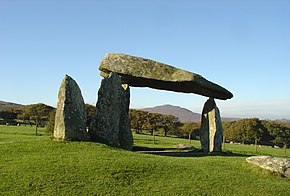Pentre Ifan

Pentre Ifan Dolmen - side view
|
|
| Alternate name | Pentre Ifan Cromlech |
|---|---|
| Location | 1km south of Pentre Ifan hamlet, in Pembrokeshire National Park. (OS Grid ref SN099370) |
| Region | West Wales |
| Coordinates | 51°59′56″N 4°46′12″W / 51.9990°N 4.7700°WCoordinates: 51°59′56″N 4°46′12″W / 51.9990°N 4.7700°W |
| Type | Dolmen |
| History | |
| Periods | Neolithic |
| Site notes | |
| Excavation dates | 1936-7, 1958-9 |
| Archaeologists | William Francis Grimes |
| Condition | Excellent |
| Public access | Yes |
| Website | cadw.wales.gov.uk |
| Designated | 1884 |
| Reference no. | PE008 |
Pentre Ifan is the name of an ancient manor in the civil parish of Nevern, Pembrokeshire, Wales. It contains and gives its name to the largest and best preserved neolithic dolmen in Wales. The Pentre Ifan monument is a Scheduled Ancient Monument and was one of three Welsh monuments to receive legal protection under the Ancient Monuments Protection Act 1882. It is now in the guardianship of Cadw, with public access.
As it now stands, the Pentre Ifan Dolmen is a collection of 7 principal stones. The largest is the huge capstone, 5 metres (16 ft) long, 2.4 metres (7.9 ft) wide and 0.9 metres (3.0 ft) thick. It is estimated to weigh 16 tonnes and rests on the tips of three other stones, some 2.5 metres (8.2 ft) off the ground. There are six upright stones, three of which support the capstone. Of the remaining three, two portal stones form an entrance and the third, at an angle, appears to block the doorway.
The dolmen dates from approximately 3,500 B.C. and has traditionally been identified as a communal burial. Under this theory the existing stones formed the portal and main chamber of the tomb, which would originally have been covered by a large mound of stones about 30 metres (98 ft) long and 17 m wide. Some of the kerbstones, marking the edge of the mound have been identified during excavations. The stone chamber was at the southern end of the long mound, which stretched off to the north. Very little of the material that formed the mound remains. Some of the stones have been scattered, but at least seven are in their original position. An elaborate entrance facade surrounding the portal, which may have been a later addition, was built with carefully constructed dry stone walling. Individual burials are thought to have been made within the stone chamber, which would be re-used many times. No trace of bones were found in the tomb, raising the possibility that they were subsequently transferred elsewhere.
A major study by Cummings and Richards in 2014 has produced a different explanation for the monument. They identify several distinctive attributes shared by the class of monument known as dolmens, all of which are particularly well exemplified at Pentre Ifan.
...
Wikipedia

